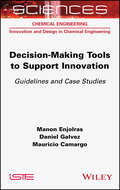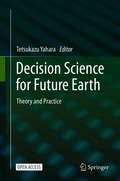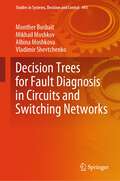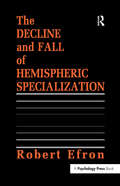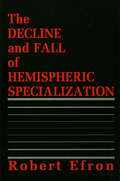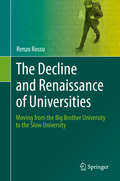- Table View
- List View
Decision Making in Natural Resource Management: A Structured, Adaptive Approach
by Michael J. Conroy James T. PetersonThis book is intended for use by natural resource managers and scientists, and students in the fields of natural resource management, ecology, and conservation biology, who are confronted with complex and difficult decision making problems. The book takes readers through the process of developing a structured approach to decision making, by firstly deconstructing decisions into component parts, which are each fully analyzed and then reassembled to form a working decision model. The book integrates common-sense ideas about problem definitions, such as the need for decisions to be driven by explicit objectives, with sophisticated approaches for modeling decision influence and incorporating feedback from monitoring programs into decision making via adaptive management. Numerous worked examples are provided for illustration, along with detailed case studies illustrating the authors’ experience in applying structured approaches. There is also a series of detailed technical appendices. An accompanying website provides computer code and data used in the worked examples. Additional resources for this book can be found at: www.wiley.com/go/conroy/naturalresourcemanagement.
Decision Making in Radiation Oncology: Volume 1 (Medical Radiology)
by Jiade J. Lu Luther W. BradyDecision Making in Radiation Oncology is a reference book designed to enable radiation oncologists, including those in training, to make diagnostic and treatment decisions effectively and efficiently. The design is based on the belief that “a picture is worth a thousand words.” Knowledge is conveyed through an illustrative approach using algorithms, schemas, graphics, and tables. Detailed guidelines are provided for multidisciplinary cancer management and radiation therapy techniques. In addition to the attention-riveting algorithms for diagnosis and treatment, strategies for the management of disease at individual stages are detailed for all the commonly diagnosed malignancies. Clinical trials that have yielded “gold standard” treatment and their results are documented in the schemas. Moreover, radiation techniques, including treatment planning and delivery, are presented in an illustrative way. This groundbreaking publication is an essential tool for physicians in their daily clinical practice.
Decision Making in Radiation Oncology: Volume 2 (Medical Radiology)
by Jiade J. Lu Luther W. BradyDecision Making in Radiation Oncology is a reference book designed to enable radiation oncologists, including those in training, to make diagnostic and treatment decisions effectively and efficiently. The design is based on the belief that “a picture is worth a thousand words.” Knowledge is conveyed through an illustrative approach using algorithms, schemas, graphics, and tables. Detailed guidelines are provided for multidisciplinary cancer management and radiation therapy techniques. In addition to the attention-riveting algorithms for diagnosis and treatment, strategies for the management of disease at individual stages are detailed for all the commonly diagnosed malignancies. Clinical trials that have yielded “gold standard” treatment and their results are documented in the schemas. Moreover, radiation techniques, including treatment planning and delivery, are presented in an illustrative way. This groundbreaking publication is an essential tool for physicians in their daily clinical practice.
Decision Making in the Manufacturing Environment: Using Graph Theory and Fuzzy Multiple Attribute Decision Making Methods (Springer Series in Advanced Manufacturing)
by Ravipudi Venkata RaoThis book shows how graph theory and matrix approach, and fuzzy multiple attribute decision making methods can be used in manufacturing. It proposes a methodology that will make decision making in the manufacturing environment structured and systematic. The book uses case studies to present the applications of decision making methods in real manufacturing situations.
Decision Making in Timber Production, Harvest, and Marketing (Routledge Revivals)
by Marion ClawsonClawson explores the issues related to timber management with a particular focus on the harvesting of timber stands in Decision Making in Timber Production, Harvest and Marketing. Originally published in 1977, her study considers biological, economic and management implications of timber growing as well as the decision-making process in U.S forest Situations including methods of analysis. This title will be of interest to students of Environmental studies and professionals.
Decision Making in Timber Production, Harvest, and Marketing (Routledge Revivals)
by Marion ClawsonClawson explores the issues related to timber management with a particular focus on the harvesting of timber stands in Decision Making in Timber Production, Harvest and Marketing. Originally published in 1977, her study considers biological, economic and management implications of timber growing as well as the decision-making process in U.S forest Situations including methods of analysis. This title will be of interest to students of Environmental studies and professionals.
Decision-making Tools to Support Innovation: Guidelines and Case Studies
by Manon Enjolras Daniel Galvez Mauricio CamargoScientific thinking concerning the way in which we drive innovation has been widely developed in recent years. It is known that the process of innovation consists of a succession of decision-making processes that require simultaneous technical, economical, organizational and sustainable compromises. Indeed, all innovative activities in business require stakeholders to seek out the best compromise between various, often contradictory dimensions of the same problems. Through studying practical cases from various fields (e.g. energy, marketing and sustainable development), this book addresses all the stages of the innovation process, highlighting some of the main decisions that can be faced by organizations. Based on the historical research conducted at the ERPI Laboratory (University of Lorraine) in Nancy, France, this book presents six innovation practices: strategy, creativity, design, project management, human resources and capitalization of knowledge. These practices are then illustrated through examples of decision support methods' applications.
Decision-making Tools to Support Innovation: Guidelines and Case Studies
by Manon Enjolras Daniel Galvez Mauricio CamargoScientific thinking concerning the way in which we drive innovation has been widely developed in recent years. It is known that the process of innovation consists of a succession of decision-making processes that require simultaneous technical, economical, organizational and sustainable compromises. Indeed, all innovative activities in business require stakeholders to seek out the best compromise between various, often contradictory dimensions of the same problems. Through studying practical cases from various fields (e.g. energy, marketing and sustainable development), this book addresses all the stages of the innovation process, highlighting some of the main decisions that can be faced by organizations. Based on the historical research conducted at the ERPI Laboratory (University of Lorraine) in Nancy, France, this book presents six innovation practices: strategy, creativity, design, project management, human resources and capitalization of knowledge. These practices are then illustrated through examples of decision support methods' applications.
Decision Making under Uncertainty: Cognitive Decision Research, Social Interaction, Development and Epistemology (ISSN #Volume 16)
by R. W. ScholzThis volume contains the revised papers of an international symposium on research on fallacies, biases, and the development of decision behavior under uncertainty. The papers are organized in five main sections.The Introduction outlines the conceptual framework and how three of the sections - Cognitive Decision Research, Social Interaction, and Development and Epistemology - are interrelated and also how new fields, such as research into developmental questions, can be productively integrated.In the fifth section Comments are collected, which evaluate the impact of the contributions on decision research itself, and also on cognitive psychology, social psychology, economic theory, ant the discipline of mathematics education.
Decision Making Using AI in Energy and Sustainability: Methods and Models for Policy and Practice (Applied Innovation and Technology Management)
by Gülgün Kayakutlu M. Özgür KayalicaArtificial intelligence (AI) has a huge impact on science and technology, including energy, where access to resources has been a source of geopolitical conflicts. AI can predict the demand and supply of renewable energy, optimize efficiency in energy systems, and improve the management of natural energy resources, among other things. This book explores the use of AI tools for improving the management of energy systems and providing sustainability with smart cities, smart facilities, smart buildings, smart transportation, and smart houses. Featuring research from International Federation for Information Processing's (IFIP) “AI in Energy and Sustainability” working group, this book provides new models and algorithms for AI applications in energy and sustainability fields. Any short-term, mid-term and long-term forecasting, optimization models, trend foresights and prescriptions based on scenarios are studied in the energy world and the smart systems for sustainability. The contents of this book are valuable for energy researchers, academics, scholars, practitioners and policy makers.
Decision Neuroscience: An Integrative Perspective
by Jean-Claude Dreher Léon TremblayDecision Neuroscience addresses fundamental questions about how the brain makes perceptual, value-based, and more complex decisions in non-social and social contexts. This book presents compelling neuroimaging, electrophysiological, lesional, and neurocomputational models in combination with hormonal and genetic approaches, which have led to a clearer understanding of the neural mechanisms behind how the brain makes decisions. The five parts of the book address distinct but inter-related topics and are designed to serve both as classroom introductions to major subareas in decision neuroscience and as advanced syntheses of all that has been accomplished in the last decade. Part I is devoted to anatomical, neurophysiological, pharmacological, and optogenetics animal studies on reinforcement-guided decision making, such as the representation of instructions, expectations, and outcomes; the updating of action values; and the evaluation process guiding choices between prospective rewards. Part II covers the topic of the neural representations of motivation, perceptual decision making, and value-based decision making in humans, combining neurcomputational models and brain imaging studies. Part III focuses on the rapidly developing field of social decision neuroscience, integrating recent mechanistic understanding of social decisions in both non-human primates and humans. Part IV covers clinical aspects involving disorders of decision making that link together basic research areas including systems, cognitive, and clinical neuroscience; this part examines dysfunctions of decision making in neurological and psychiatric disorders, such as Parkinson’s disease, schizophrenia, behavioral addictions, and focal brain lesions. Part V focuses on the roles of various hormones (cortisol, oxytocin, ghrelin/leptine) and genes that underlie inter-individual differences observed with stress, food choices, and social decision-making processes. The volume is essential reading for anyone interested in decision making neuroscience. With contributions that are forward-looking assessments of the current and future issues faced by researchers, Decision Neuroscience is essential reading for anyone interested in decision-making neuroscience. Provides comprehensive coverage of approaches to studying individual and social decision neuroscience, including primate neurophysiology, brain imaging in healthy humans and in various disorders, and genetic and hormonal influences on decision makingCovers multiple levels of analysis, from molecular mechanisms to neural-systems dynamics and computational models of how we make choicesDiscusses clinical implications of process dysfunctions, including schizophrenia, Parkinson’s disease, eating disorders, drug addiction, and pathological gamblingFeatures chapters from top international researchers in the field and full-color presentation throughout with numerous illustrations to highlight key concepts
Decision Processes in Dynamic Probabilistic Systems (Mathematics and its Applications #42)
by A.V. GheorgheDecision Science for Future Earth: Theory and Practice
by Tetsukazu YaharaThis open access book provides a theoretical framework and case studies on decision science for regional sustainability by integrating the natural and social sciences. The cases discussed include solution-oriented transdisciplinary studies on the environment, disasters, health, governance and human cooperation. Based on these case studies and comprehensive reviews of relevant works, including lessons learned from past failures for predictable surprises and successes in adaptive co-management, the book provides the reader with new perspectives on how we can co-design collaborative projects with various conflicts of interest and how we can transform our society for a sustainable future. The book makes a valuable contribution to the global research initiative Future Earth, promoting transdisciplinary studies to bridge the gap between science and society in knowledge generation processes and supporting efforts to achieve the UN’s Sustainable Development Goals (SDGs). Compared to other publications on transdisciplinary studies, this book is unique in that evolutionary biology is used as an integrator for various areas related to human decision-making, and approaches social changes as processes of adaptive learning and evolution. Given its scope, the book is highly recommended to all readers seeking an integrated overview of human decision-making in the context of social transformation.
Decision Support for Forest Management (Managing Forest Ecosystems #30)
by Annika Kangas Mikko Kurttila Teppo Hujala Kyle Eyvindson Jyrki KangasThis updated and expanded second edition adds the most recent advances in participatory planning approaches and methods, giving special emphasis to decision support tools usable under uncertainty. The new edition places emphasis on the selection of criteria and creating alternatives in practical multi-criteria decision making problems.
Decision Support for Natural Disasters and Intentional Threats to Water Security (NATO Science for Peace and Security Series C: Environmental Security)
by Tissa Illangasekare Katarina Mahutova John J. BarichThe NATO Advanced Research Workshop, “Decision Support for Natural Disasters and Intentional Threats to Water Security” was the result of close collaboration between environmental, security, water resource, and health officials in the United States and Croatia. The premise of the Workshop is that multiple, disparate threats to water security exist, and that shared decision support structures provide effective means for avoiding and responding to potential or actual situations. The Workshop was co-directed by Professors Tissa Illangasekare of the Colorado School of Mines, and Dragutin Geres of Hrvatske vode. The Workshop was organized into a series of case studies, presentation of management tools, or a combination of the two. Presentations were further organized as to (1) Natural Occurrences, (2) Anthropogenic Causes, and (3) Decision Support Tools. Delegates from eleven countries assembled to explore these topics at the Hotel Dubrovnik President in Dubrovnik from April 22–25, 2007. A total of thirty delegates from NATO, Partner, Mediterranean Dialog, or other countries were in attendance. The final program included technical sessions using a presentation and dialog format, a field trip, and networking sessions. There were twenty five technical presentations supported by seventeen formal papers (many updated in late-2008 and 2009), and these form the basis for these proceedings. xi ACKNOWLEDGEMENTS The co-directors and organizers of this Advanced Research Workshop a- nowledge the NATO Science Programme for major financial support and for providing detailed guidance on how best to organize and execute a meeting of this nature.
Decision Support Systems: Water Resources Planning (Nato ASI Subseries G: #26)
by Daniel P. Loucks Joao R. Da CostaProceedings of the NATO Advanced Research Workshop on Computer-Aided Support Systems for Water Resources, Research and Management held at Ericeira (Portugal), 24-28 September, 1990.
Decision Support Systems for Risk-Based Management of Contaminated Sites (Lecture Notes In Mathematics #Vol. 767)
by Andrea Critto Antonio Marcomini Glenn Walter Suter IIDecision Support Systems for Risk-Based Management of Contaminated Sites addresses decision making in environmental risk management for contaminated sites, focusing on the potential role of decision support systems in informing the management of chemical pollutants and their effects. Considering the environmental relevance and the financial impacts of contaminated sites all over the post-industrialized countries and the complexity of decision making in environmental risk management, decision support systems can be used by decision makers in order to have a more structured analysis of a problem at hand and define possible options of intervention to solve the problem. Accordingly, the book provides an analysis of the main steps and tools for the development of decision support systems, namely: environmental risk assessment, decision analysis, spatial analysis and geographic information system, indicators and endpoints. Sections are dedicated to the review of decision support systems for contaminated land management and for inland and coastal waters management. Both include discussions of management problem formulation and of the application of specific decision support systems. This book is a valuable support for environmental risk managers and for decision makers involved in a sustainable management of contaminated sites, including contaminated lands, river basins and coastal lagoons. Furthermore, it is a basic tool for the environmental scientists who gather data and perform assessments to support decisions, developers of decision support systems, students of environmental science and members of the public who wish to understand the assessment science that supports remedial decisions.
Decision Support Systems for Weed Management
by Guillermo R. Chantre José L. González-AndújarWeed management Decision Support Systems (DSS) are increasingly important computer-based tools for modern agriculture. Nowadays, extensive agriculture has become highly dependent on external inputs and both economic costs, as well the negative environmental impact of agricultural activities, demands knowledge-based technology for the optimization and protection of non-renewable resources. In this context, weed management strategies should aim to maximize economic profit by preserving and enhancing agricultural systems. Although previous contributions focusing on weed biology and weed management provide valuable insight on many aspects of weed species ecology and practical guides for weed control, no attempts have been made to highlight the forthcoming importance of DSS in weed management. This book is a first attempt to integrate `concepts and practice’ providing a novel guide to the state-of-art of DSS and the future prospects which hopefully would be of interest to higher-level students, academics and professionals in related areas.
Decision System in Agricultural Pest Management
by Ali Rajabpour Fatemeh YarahmadiThis book covers the theoretical and practical aspects of pest population components, explaining the probable reasons for pest density fluctuations and outbreaks in agricultural or other ecosystems. Agricultural pest management is a complex task that involves dealing with a variety of pests, including insects, diseases, and weeds. Decision systems can help farmers navigate this complexity by providing structured approaches to identify, monitor, and control pests. By making informed decisions based on data and models, farmers can reduce unnecessary pesticide applications, minimizing environmental impact and saving costs. This book aids in predicting pest outbreaks using population growth parameters and estimating economic crop losses through critical thresholds, illustrated with simple case studies. Additionally, the book covers image processing, remote sensing monitoring, and other novel methods for monitoring and quickly forecasting pest population outbreaks to developintegrated pest management (IPM) programs. The book is valuable for agricultural and entomological students (graduates and postgraduates), researchers, as well as pest managers and farmers.
Decision Theory and Choices: a Complexity Approach (New Economic Windows)
by Marisa Faggini Concetto Paolo VinciIn economics agents are assumed to choose on the basis of rational calculations aimed at the maximization of their pleasure or profit. Formally, agents are said to manifest transitive and consistent preferences in attempting to maximize their utility in the presence of several constraints. They operate according to the choice imperative: given a set of alternatives, choose the best. This imperative works well in a static and simplistic framework, but it may fail or vary when 'the best' is changing continuously. This approach has been questioned by a descriptive approach that springing from the complexity theory tries to give a scientific basis to the way in which individuals really choose, showing that those models of human nature is routinely falsified by experiments since people are neither selfish nor rational. Thus inductive rules of thumb are usually implemented in order to make decisions in the presence of incomplete and heterogeneous information sets.
Decision Trees for Fault Diagnosis in Circuits and Switching Networks (Studies in Systems, Decision and Control #493)
by Monther Busbait Mikhail Moshkov Albina Moshkova Vladimir ShevtchenkoIn this book, we study decision trees for fault diagnosis in circuits and switching networks, which are among the most fundamental models for computing Boolean functions. We consider two main cases: when the scheme (circuit or switching network) has the same mode of operation for both calculation and diagnostics, and when the scheme has two modes of operation—normal for calculation and special for diagnostics. In the former case, we get mostly negative results, including superpolynomial lower bounds on the minimum depth of diagnostic decision trees depending on scheme complexity and the NP-hardness of construction diagnostic decision trees. In the latter case, we describe classes of schemes and types of faults for which decision trees can be effectively used to diagnose schemes, when they are transformed into so-called iteration-free schemes. The tools and results discussed in this book help to understand both the possibilities and challenges of using decision trees to diagnose faults in various schemes. The book is useful to specialists both in the field of theoretical and technical diagnostics.It can also be used for the creation of courses for graduate students.
Deckungsbeitragsrechnung für Ingenieure (essentials)
by Ekbert HeringDeckungsbeiträge dienen dazu, die Fixkosten eines Unternehmens bzw. der Unternehmensbereiche zu decken. Dazu müssen die fixen und die variablen Kosten bekannt sein. Der Deckungsbeitrag DB errechnet sich aus: DB = Netto-Umsatz – variable Kosten. Diese Kenngröße kann aus der Kostenrechnung leicht ermittelt werden, da Netto-Umsatz und variable Kosten in der Regel bekannt sind. Mit einer mehrstufigen Deckungsbeitragsrechnung können verschiedene Preisuntergrenzen definiert werden. Mit Deckungsbeiträgen können auch Marktpreise kalkuliert und eine Break-Even-Analyse durchgeführt werden (Bestimmung des Break-Even-Umsatzes: Umsatz, bei der gerade kein Gewinn oder Verlust auftritt oder der Break-Even-Stückzahl: Mindeststückzahl bei Gewinn = 0). Ausführliche Beispiele und Grafiken veranschaulichen die Zusammenhänge.
The Decline and Fall of Hemispheric Specialization (Distinguished Lecture Series)
by Robert EfronProviding a personal overview of hemispheric differences in human cognitive activity, Professor Efron is selective in his presentation of significant issues. To ensure a balanced overview, references are made to many books, review articles, and research reports that present opposing positions. Although additional material has been included in this book, the informal style of the oral presentation has not been altered. This volume may be perceived as a report of one man's opinion; however, the conclusions may reflect the views of a "silent majority" of cognitive neuroscientists.
The Decline and Fall of Hemispheric Specialization (Distinguished Lecture Series)
by Robert EfronProviding a personal overview of hemispheric differences in human cognitive activity, Professor Efron is selective in his presentation of significant issues. To ensure a balanced overview, references are made to many books, review articles, and research reports that present opposing positions. Although additional material has been included in this book, the informal style of the oral presentation has not been altered. This volume may be perceived as a report of one man's opinion; however, the conclusions may reflect the views of a "silent majority" of cognitive neuroscientists.
The Decline and Renaissance of Universities: Moving from the Big Brother University to the Slow University
by Renzo RossoInstead of following the Magna Charta Universitatum, the declaration of the principles of knowledge signed in 1988 in Bologna, the academic approach pursued in Europe and the other continents over the past 30 years has strictly employed a utilitarian model of higher education. This jeopardizes academic freedom, shared governance and tenure, the three pillars of the long-established model of universities. Scientific conformism and fragmentation, educational bias and authoritarianism are the major drawbacks, together with a poor readiness to meet the emerging challenges in the labor market and technology. In this book, Renzo Rosso presents a new model for countering these developments, e.g. by establishing novel democratic rules for university governance. The Slow University paradigm positions culture and education as essential tools for the long-term survival of humankind.





